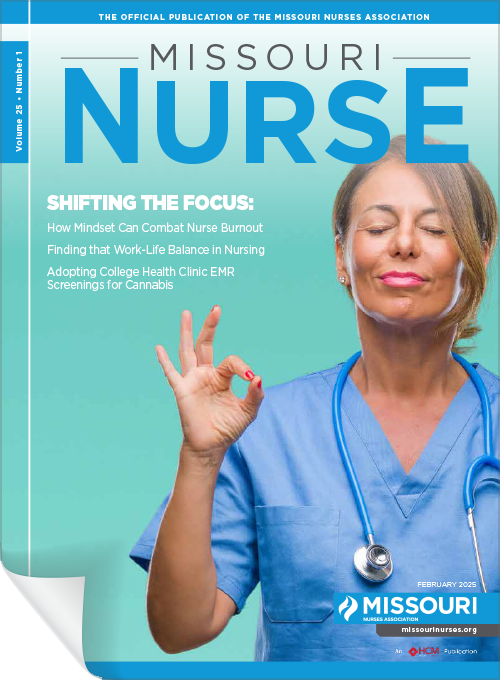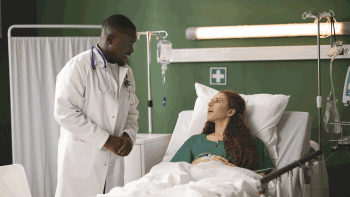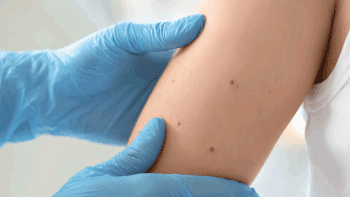Below are recent articles from
Missouri Nurse, the official publication of the Missouri Nurses Association.
Health News: Pearls for Publishing with Multiple Authors
Happy to Be HAP-Free: The Role of Oral Care in Preventing Hospital-Acquired Pneumonia in Non-Ventilated Patients
From Burnout to Breakthrough: Transforming Nursing Culture Through Conflict Management
Finding that Work-Life Balance in Nursing Today
Shifting the Focus: How Mindset Can Combat Nurse Burnout
Adopting College Health Clinic EMR Screenings for Cannabis
From the MONA Executive Director, February 2025
From the MONA President, February 2025
Nurse Practitioner License Protection Case Study: Failure to Document Medication Management in Accordance with the Standard of Care
A STATE BOARD OF NURSING (SBON) complaint may be filed against a nurse practitioner (NP) by a patient, a patient’s family member, colleague, employer, and/or other regulatory agency, such as the Department of Health.
Utilizing Academic-Clinical Partnerships to Improve New Graduate Nurse Recruitment and Retention
Health News: Pearls for Publishing with Multiple Authors
Happy to Be HAP-Free: The Role of Oral Care in Preventing Hospital-Acquired Pneumonia in Non-Ventilated Patients
From Burnout to Breakthrough: Transforming Nursing Culture Through Conflict Management
Finding that Work-Life Balance in Nursing Today
Shifting the Focus: How Mindset Can Combat Nurse Burnout
Adopting College Health Clinic EMR Screenings for Cannabis
From the MONA Executive Director, February 2025
From the MONA President, February 2025
Nurse Practitioner License Protection Case Study: Failure to Document Medication Management in Accordance with the Standard of Care
Utilizing Academic-Clinical Partnerships to Improve New Graduate Nurse Recruitment and Retention
Articles From American Nurse that you may be interested in
PTSD: Increase screening and treatment
Many nurse practitioners (NPs) provide care in medically underserved areas, some in one of the more than 1,400 free clinics throughout the United States. More patients who access care at free clinics meet the diagnostic criteria for posttraumatic stress disorder (PTSD) than those who receive care at fee-for-service clinics.
Acute kidney injury: A quick diagnosis aids recovery
A 35-year-old man arrives at the ED with severe weakness, diarrhea, nausea, hypotension, and tachycardia, which began after he finished a 100-mile race the previous day. Urinalysis indicates the presence of protein, blood, and an elevated specific gravity. The patient’s medications include citalopram for depression and ibuprofen for a recent knee injury. The patient says, “I’ve been taking more ibuprofen than I normally do, and I wish I’d stopped at more drink stations during the race.”
Cannabis and healthcare: Complicated policies and laws
A physician authorizes medical cannabis for an 18-year-old student who lives in a college dorm in a state where cannabis is legal for recreational use by anyone over 21 and also by minors with guardian approval. However, campus policy prohibits the use and storage of cannabis. College health center staff tell the student that his parents will need to store the cannabis and take him off campus to use it. The student’s family struggles to respond as their child ponders the risk of engaging in activities deemed legal in one context but illegal in another.
Women and HIV pre-exposure prophylaxis
Why are new HIV cases still occurring when we have preventive treatment? One reason could be a lack of knowledge and experience among healthcare professionals to discuss, prescribe, and manage PrEP for vulnerable patients. Lack of information and discomfort with prescribing PrEP remain ongoing issues among healthcare professionals in the United States. Healthcare professionals should know how to identify appropriate candidates for PrEP, provide general education, and prescribe necessary preventive treatment.
Empathy in ostomy care
Nurse leader rounds plus
Nurses’ role in skin cancer prevention
Top post-pandemic global health concerns
Nurse Resource Center
Graceland University
With over 50 years of experience educating nurses, we offer BSN, MSN-FNP, MSN-AGACNP, MSN-PMHNP, & DNP degrees. Our MSN degrees & certs are customizable with 3 start terms.
MoDocs
Get the GOLD standard in Medical Liability Coverage. Where Missouri’s NPs, CRNAs, PAs and physicians get affordable rates, the best protection and smart, vigorous legal defense.
Cmh
Recruiting experts to care for our patients. RN and LPN opportunities in acute care, physician clinics, skilled nursing and home care. Ask about or loan forgiveness program & new salary schedule.





























